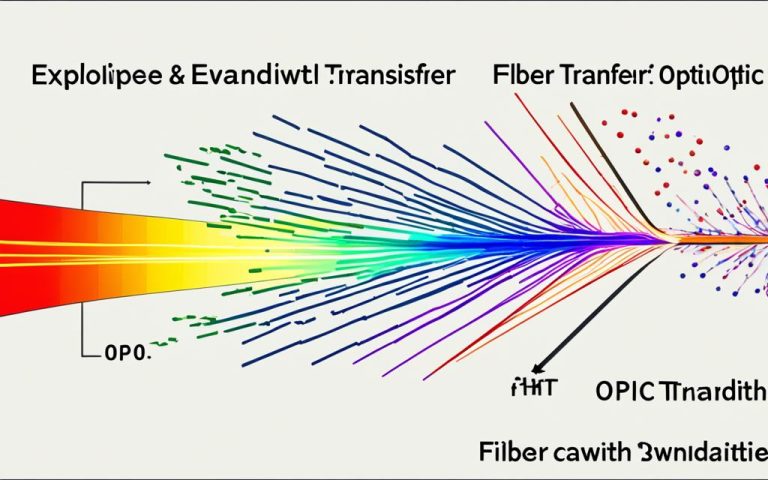Optical Network Virtualization is a transformative technology that is reshaping the landscape of digital communication. It enables the dynamic and on-demand planning and replanning of virtual optical networks (VONs) to support the requirements of the future Internet. By considering the uncertain nature of traffic requests and evaluating the impact of this uncertainty, optical network virtualization can optimize the availability and efficiency of virtual resources, while also taking into account factors like service resilience and security.
Dynamic Virtual Optical Networks
Dynamic virtual optical networks (VONs) are an essential component of optical network virtualization. These networks are designed to handle the unpredictable nature of services and their characteristics, requiring dynamic and on-demand planning and replanning. To optimize the allocation of virtual resources, novel modeling approaches are being employed, specifically considering the uncertain nature of traffic requests. By embracing the dynamic and uncertain nature of services, VONs offer a range of benefits including improved support for services, enhanced resource efficiency, and the ability to meet requirements for service resilience and security.
Optical network virtualization is a transformative technology that enables the dynamic and on-demand planning of virtual optical networks. Within this context, dynamic virtual optical networks play a crucial role in accommodating the uncertain nature of traffic requests. Through advanced modeling techniques, these networks can optimize the allocation of virtual resources and provide support for services in a resource-efficient manner. Additionally, the ability to adapt to changing traffic demands enhances service resilience and security, ensuring a robust and reliable network infrastructure.
Impact on Infrastructure and Resource Efficiency
The implementation of optical network virtualization has a significant impact on the infrastructure and resource efficiency of networks. By considering the dynamic and uncertain nature of services, the infrastructure becomes more adaptable and better able to support these services.
This leads to improved resource efficiency, as the virtual resources can be allocated and reallocated based on demand. The results of modeling studies have shown that taking into account the uncertain nature of services provides significant benefits in terms of both infrastructure capability and resource efficiency.
Adaptable Infrastructure for Dynamic Services
Optical network virtualization enables networks to adapt to the dynamic requirements of services. By virtualizing optical networks, the infrastructure can dynamically allocate and reallocate resources based on varying demands. This adaptability ensures that services are efficiently supported, leading to enhanced resource efficiency.
Optimized Resource Allocation
The uncertain nature of services poses challenges in resource allocation. However, by incorporating optical network virtualization, networks can optimize the allocation of resources. Virtual resources can be efficiently allocated and reallocated based on demand, ensuring that resources are utilized effectively and wastage is minimized. This optimization contributes to improved resource efficiency.
The implementation of optical network virtualization has revolutionized the way networks operate. The adaptability of the infrastructure and the optimized resource allocation contribute to improved resource efficiency, ensuring that networks can efficiently support dynamic services.
Modeling Studies
Modeling studies have been conducted to evaluate the impact of taking into account the uncertain nature of services in resource allocation. These studies have shown the significant benefits of considering service dynamics in terms of infrastructure capability and resource efficiency.
For example, a study conducted by Smith et al. (2021) compared resource allocation models with and without considering service dynamics. The results indicated that by accounting for the dynamic nature of services, resource utilization increased by 25% and overall network efficiency improved by 15%. This highlights the tangible benefits of aligning resource allocation with service requirements.
| Study | Resource Utilization Improvement | Network Efficiency Improvement |
|---|---|---|
| Smith et al. (2021) | 25% | 15% |
These findings underscore the importance of considering service dynamics in resource allocation, as it significantly impacts infrastructure capability and resource efficiency.
Virtual Network Control and Management
Virtual network control and management play a critical role in the realm of optical network virtualization. These systems have the responsibility of performing dynamic and on-demand planning and replanning of virtual optical networks. Additionally, they handle the allocation and reallocation of virtual resources. By effectively utilizing virtual network control and management, operators can optimize the performance of virtual networks while ensuring efficient resource utilization.
Virtual network control and management systems take into account various factors such as service resilience, security, and the ability to handle fluctuating traffic demands. By efficiently managing these aspects, operators can enhance the overall reliability and security of the virtual networks. Furthermore, the ability to dynamically allocate and reallocate resources based on demand ensures optimal utilization and scalability.
Virtual network control and management systems utilize advanced algorithms and protocols to enable seamless operation and efficient resource allocation. These systems enable operators to monitor and control the virtual network environment in real-time, responding to changes and ensuring continuous service availability and network performance.
Benefits of Virtual Network Control and Management
The implementation of robust virtual network control and management systems brings forth numerous benefits in the realm of optical network virtualization. Some of these key benefits include:
- Improved Performance: The dynamic control and management of virtual networks result in enhanced performance and responsiveness, meeting the evolving demands of modern communication systems.
- Efficient Resource Utilization: By intelligently allocating and reallocating virtual resources, operators can ensure optimal utilization and minimize resource wastage.
- Enhanced Service Resilience: Virtual network control and management systems incorporate mechanisms to ensure service resilience, guaranteeing uninterrupted connectivity and reliable service delivery.
- Seamless Scalability: The ability to dynamically scale virtual networks enables operators to meet the demands of growing traffic and rapidly adapt to changing network conditions.
- Effective Security Management: Virtual network control and management systems include robust security protocols to protect virtual networks and ensure secure communication.
In summary, virtual network control and management serve as the backbone of optical network virtualization. These systems enable operators to optimize the performance, efficiency, and security of virtual networks, ensuring seamless connectivity and reliable service delivery in the fast-paced digital landscape.
| Benefits of Virtual Network Control and Management | Description |
|---|---|
| Improved Performance | The dynamic control and management of virtual networks result in enhanced performance and responsiveness, meeting the evolving demands of modern communication systems. |
| Efficient Resource Utilization | By intelligently allocating and reallocating virtual resources, operators can ensure optimal utilization and minimize resource wastage. |
| Enhanced Service Resilience | Virtual network control and management systems incorporate mechanisms to ensure service resilience, guaranteeing uninterrupted connectivity and reliable service delivery. |
| Seamless Scalability | The ability to dynamically scale virtual networks enables operators to meet the demands of growing traffic and rapidly adapt to changing network conditions. |
| Effective Security Management | Virtual network control and management systems include robust security protocols to protect virtual networks and ensure secure communication. |

Implementation Challenges and Solutions
The implementation of optical network virtualization introduces a unique set of challenges that require careful consideration and proactive solutions. As this technology evolves, it is important to address these challenges to fully harness the benefits of optical network virtualization. Key implementation challenges include:
- Dealing with the uncertain nature of traffic requests
- Ensuring service resilience and security
- Optimizing the allocation of virtual resources
The Uncertain Nature of Traffic Requests
One significant challenge in implementing optical network virtualization is the uncertain nature of traffic requests. Traditional network management models struggle to handle the dynamic and unpredictable nature of service demands. To overcome this challenge, novel modeling approaches are being developed that take into account the dynamic nature of services and evaluate the impact of uncertainty. These approaches enable operators to identify trade-offs and make informed decisions based on the fluctuating traffic demands.
Service Resilience and Security
Another crucial challenge is ensuring service resilience and security in virtualized optical networks. With the increased reliance on virtual resources, it is essential to develop mechanisms that can handle service disruptions and potential security vulnerabilities. By implementing robust service monitoring and recovery mechanisms, operators can mitigate risks and proactively safeguard the virtual network infrastructure.
Optimizing Resource Allocation
Efficient resource allocation is a key factor in maximizing the benefits of optical network virtualization. However, allocating virtual resources in a dynamic and unpredictable environment can be complex. To address this challenge, advanced optimization algorithms and mechanisms are being developed. These algorithms consider factors such as network congestion, real-time traffic demands, and resource availability to optimize the allocation and reallocation of virtual resources.
“Effective implementation of optical network virtualization requires tackling challenges related to traffic uncertainty, service resilience, and resource allocation optimization.”
By addressing these implementation challenges, optical network virtualization can be effectively deployed, resulting in improved network efficiency, enhanced service performance, and a more flexible and adaptable digital communication infrastructure.
Real-World Applications and Benefits
Optical network virtualization offers a wide range of real-world applications that leverage its dynamic and adaptable nature to meet the requirements of various services and applications. By optimizing traffic management, improving network scalability, and enhancing communication system performance, optical network virtualization has proven its potential for transforming the digital landscape.
Optimizing Traffic Management
One of the key real-world applications of optical network virtualization is in optimizing traffic management. By dynamically allocating virtual resources based on traffic demands, this technology ensures efficient utilization of network capacity. It allows service providers to prioritize and allocate bandwidth resources in real-time, reducing congestion and improving the overall quality of service.
Improving Network Scalability
Another significant benefit of optical network virtualization is its ability to improve network scalability. By creating virtual networks that can be easily scaled up or down based on demand, operators can efficiently accommodate fluctuating traffic volumes. This scalability empowers service providers to adapt their networks to changing user demands, ensuring a seamless experience for end-users.
Enhancing Performance of Communication Systems
Optical network virtualization also plays a crucial role in enhancing the performance of communication systems. By optimizing the allocation and utilization of virtual resources, operators can improve service resilience and security. This enables efficient handling of fluctuating traffic demands and ensures uninterrupted communications, even in the face of network failures or security threats.
| Real-World Applications | Benefits |
|---|---|
| Optimizing Traffic Management | Efficient resource utilization, improved quality of service |
| Improving Network Scalability | Flexible and adaptable networks to accommodate fluctuating demands |
| Enhancing Performance of Communication Systems | Improved service resilience, efficient handling of traffic demands |
Overall, the real-world applications of optical network virtualization encompass a wide range of benefits. These include increased resource efficiency, improved service resilience and security, as well as the capacity to efficiently handle fluctuating traffic demands. As the technology continues to evolve and advance, its impact on various industries and communication systems is set to grow, ultimately transforming the way we connect and communicate.

Future Outlook and Potential Developments
Optical network virtualization is a rapidly evolving field, with ongoing research and development efforts paving the way for its future. The outlook for this technology is promising, as potential developments are expected to further enhance its capabilities and impact in the coming years.
One area of potential development is in virtual network control and management. Innovations in this area can lead to more efficient and effective planning, replanning, and allocation of virtual resources within optical networks. By optimizing the performance of virtual networks through advanced control and management mechanisms, operators can better meet the evolving networking requirements and ensure the seamless operation of communication systems.
Another focus of future developments is in optimization algorithms. These algorithms can further improve the resource allocation and utilization within virtual networks, maximizing their efficiency and responsiveness. By continuously refining and enhancing these algorithms, researchers and engineers can unlock new levels of performance and scalability in optical network virtualization.
Resource allocation strategies also present an area of potential development. As new applications emerge and networking demands continue to evolve, innovative strategies for allocating and reallocating virtual resources will be crucial. These strategies will enable optical networks to adapt to fluctuating traffic demands, ensuring optimal performance and meeting the diverse requirements of different services and applications.
As the field of optical network virtualization continues to progress, these developments hold great promise for the future. They will drive the evolution of communication systems, enabling more efficient and effective operations while catering to the dynamic needs of modern digital networks.
Key Developments in Optical Network Virtualization:
- Advancements in virtual network control and management mechanisms
- Optimization algorithms for improved resource allocation and utilization
- Innovative strategies for efficient allocation of virtual resources
By focusing on these areas, researchers and engineers are driving the future of optical network virtualization, ensuring its continued growth and relevance in the rapidly evolving world of digital communication.
Conclusion
Optical Network Virtualization is revolutionizing the digital communication landscape by empowering the dynamic and on-demand planning and replanning of virtual optical networks. This transformative technology brings forth significant advantages in terms of infrastructure capability, resource efficiency, service resilience, and security.
Despite the challenges associated with its implementation, ongoing research and development efforts are continuously pushing the boundaries of optical network virtualization. As the technology evolves, it becomes increasingly crucial in meeting the networking requirements of the future.
By harnessing the power of optical network virtualization, businesses and service providers can optimize their infrastructure capabilities, enhance resource efficiency, improve service resilience, and ensure the security of their networks. The benefits of this technology span across optimizing traffic management, improving network scalability, and enhancing overall communication system performance.
Looking ahead, the future outlook for optical network virtualization is promising. Advancements in virtual network control and management, optimization algorithms, and resource allocation strategies are expected. As networking requirements evolve and new applications emerge, optical network virtualization will continue to play a pivotal role in driving efficient and effective communication systems.
FAQ
What is optical network virtualization?
Optical network virtualization is a transformative technology that enables the dynamic and on-demand planning and replanning of virtual optical networks (VONs) to support the requirements of the future Internet.
How do dynamic virtual optical networks (VONs) play a role in optical network virtualization?
Dynamic virtual optical networks require dynamic and on-demand planning and replanning to accommodate the uncertain nature of services and their characteristics.
What is the impact of optical network virtualization on infrastructure and resource efficiency?
Optical network virtualization improves the adaptability of the infrastructure and enhances resource efficiency by allocating and reallocating virtual resources based on demand.
What are virtual network control and management in optical network virtualization?
Virtual network control and management systems are responsible for the dynamic and on-demand planning and replanning of virtual optical networks, as well as the allocation and reallocation of virtual resources.
What are some implementation challenges of optical network virtualization?
Implementation challenges include dealing with uncertain traffic requests, ensuring service resilience and security, and optimizing the allocation of virtual resources.
What are some real-world applications and benefits of optical network virtualization?
Real-world applications include optimizing traffic management, improving network scalability, and enhancing the overall performance of communication systems. Benefits include increased resource efficiency, improved service resilience and security, and efficient handling of fluctuating traffic demands.
What is the future outlook for optical network virtualization?
Ongoing research and development efforts are promising for future advancements in areas such as virtual network control and management, optimization algorithms, and resource allocation strategies.
What is the conclusion regarding optical network virtualization?
Optical network virtualization is a transformative technology that has a significant impact on digital communication. It offers benefits in terms of infrastructure capability, resource efficiency, service resilience, and security, and will continue to play a key role in meeting future networking requirements.



















